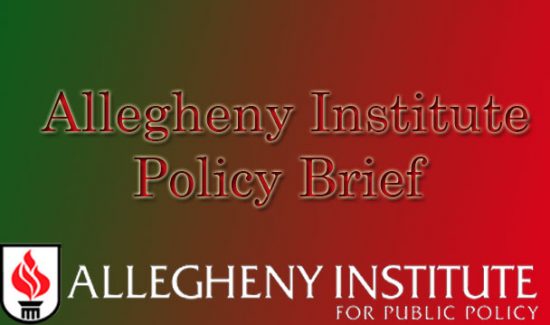Budget Impasse Not Halting State Government
(October 26, 2015)–While it appears November will appear before a Governor signed state budget does, a large share of the Commonwealth’s government operations are going along as if there was no impasse.
This is due to two important factors. First, while the budget disagreement between the Legislature and the Governor involves the state’s largest single operating fund—the general fund, which stood at $29 billion in the 2014-15 Fiscal Year—the budget for last Fiscal Year completed on June 30th 2014 notes among its hundreds of pages that "The total 2014-15 operating budget for the commonwealth is $71.8 billion. It includes $29.4 billion in the General Fund, nearly $2.7 billion in the Motor License Fund, more than $24.2 billion in federal funds and $15.5 billion in fees and other special fund revenues." Thus, $42 billion was to be spent during the year that does not flow through the budgeted General Fund.
Second, the Office of the Budget has created a "frequently asked questions" document about the impasse which notes that the lack of a budget does not affect any operations that involve "…critical functions that impact the health, safety, and/or welfare of the citizens of Pennsylvania". Of course, that covers a wide range of government functions. For instance, there is no restricted access to Commonwealth facilities and payments for services such as child care subsidy payments, prescription drug coverage under the PACE program, pension programs for Blind and Paralyzed Veterans, along with Medicare Part A and B premium payments which are being made. Highway work is not being halted. The Allegheny County Port Authority, which gets its state operating assistance from the Public Transportation Assistance Fund, is being funded, which presumably would be true for other mass transit operators across the state.
Here is a look at three key areas, the first two of which are not affected by the impasse:
• Commonwealth employee payroll, including pension contributions
• State tax collections
• State funding for school districts
A 2009 Pennsylvania Supreme Court decision ruled that the Federal Fair Labor Standards Act superseded the language of the Pennsylvania Constitution and, according to a legal analysis of that case, "…does not prohibit payment of employee wages during an impasse". Those payments are likely a large part of the $26 billion in "expense transactions" that have been processed since the start of the Fiscal Year by the Treasury.
Also not affected are tax collections. The Department of Revenue has released three monthly totals in the current Fiscal Year thus far—July, August, and September of 2015. Overall general fund collections were reported at $2.2 billion, $1.9 billion, and $2.7 billion, respectively, a $6.8 billion total. In the same three months last year, the total was $6.6 billion. The main components of that revenue total, taxes on sales and personal income, were not too far off from the Fiscal Year to date totals from last September. Sales taxes brought in $2.5 billion from July-September 2015 ($2.4 billion last July-September) and personal income taxes totaled $2.8 billion ($2.6 billion last July-September).
On the other hand there are functions not receiving money. As the Office of the Budget points out in regards to state funding for schools, "to the extent these funds must be appropriated by the General Assembly, payments will not be processed until a budget is approved for FY 2015-16". So while school districts are not getting state money the funds for the state Department of Education appear to be unaffected by the impasse.
The Auditor General’s office noted in a September 29th press release that school districts, especially those more reliant on state money than local money, have had to borrow funds. In Allegheny County, Clairton, McKeesport Area, and Sto-Rox borrowed a combined $14.3 million (in Fiscal Year 2013-14 these three districts received a combined $58.8 million in state funding). Undoubtedly, as the impasse drags on, other districts that depend heavily on the state for funding will be asking for revenue anticipation loans. Note that some less well-off districts get 75 percent or more of their total revenue from the state while richer districts receive 15 percent or less.
A request by the Erie School District for the Treasury to authorize a $47 million loan was rejected because "…[the] Treasury may only make payments pursuant to a request from a state agency — the executive, legislature or judicial. No such request has been made by the Department of Education."
But the bottom line at this point of the impasse is that employment effects have been negligible. Bureau of Labor Statistics data on state and area employment, hours, and earnings show that from September 2014 to September 2015 state government employment is actually up 600 employees while local government, educational services (school districts) is down 4,500. It is unlikely the decline in school employment is due to the impasse since the changes from 12 months earlier have been down substantially throughout all of 2015 including the six months before the deadline for the budget passed. Indeed, local education employment has been dropping since 2009.
Some social services agencies have complained about loss of funding but the total jobs in that sector are up by 4,700 between September 2014 and September 2015. So far, there appears to have been no major impact.
Amazingly, for all the angst about the budget impasse there is not much evidence of real hardship. Little wonder there is not more urgency on the part of the Governor to make a deal the Legislature can accept.
Jake Haulk, Ph.D., President
Eric Montarti, Senior Policy Analyst
If you wish to support our efforts please consider becoming a donor to the Allegheny Institute.The Allegheny Institute is a 501(c)(3) non-profit organization and all contributions are tax deductible.Please mail your contribution to:
The Allegheny Institute
305 Mt. Lebanon Boulevard
Suite 208
Pittsburgh, PA15234





